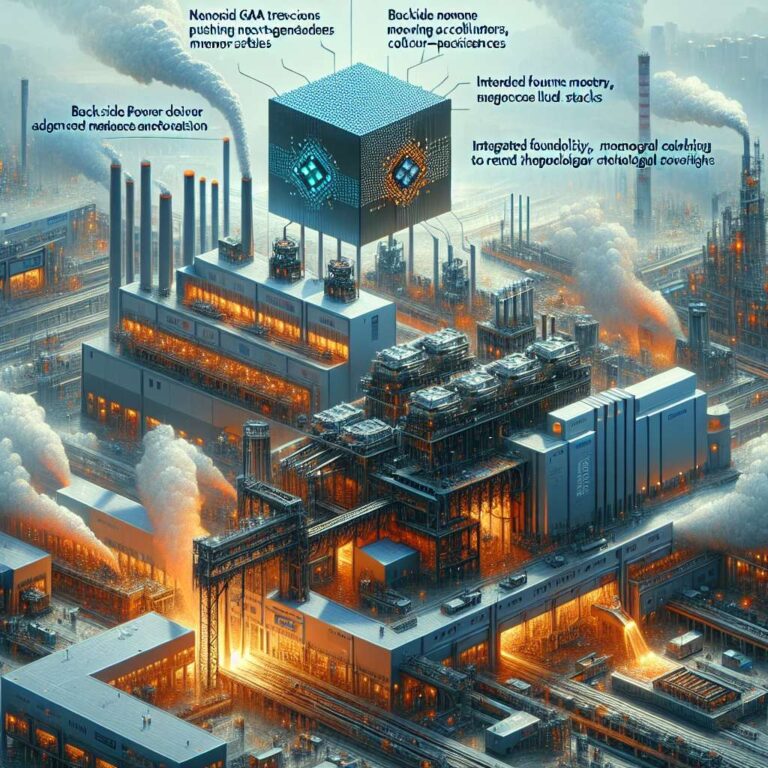The global foundry market is being reshaped by surging demand for advanced Artificial Intelligence hardware and rising geopolitical stakes. Market leader TSMC, alongside Samsung Foundry and Intel Foundry Services, is racing to deliver smaller, faster, and more efficient chips while expanding advanced packaging to feed an ecosystem hungry for accelerators powering large language models, autonomous systems, and hyperscale cloud workloads. The contest is about far more than share gains. It is about who sets the pace of Artificial Intelligence innovation and who secures national-level technological sovereignty.
On the technology front, TSMC continues to execute with 3 nm FinFET in volume since late 2022 and an expanded N3 family, while targeting mass production of 2 nm (N2) in late 2025 with a move to nanosheet GAA transistors. Its CoWoS and SoIC packaging are pivotal for bandwidth-hungry accelerators, with CoWoS capacity fully booked through 2025 and SoIC capacity slated to grow eightfold by 2026. Samsung was first to introduce GAAFET at 3 nm via MBCFET in 2022 and is developing 2 nm (SF2) and 1.4 nm nodes, with SF2Z bringing a backside power delivery network in 2027. Its I-Cube and X-Cube packaging underpin a one-stop model that aims to cut manufacturing time by 20 percent. Intel’s 18A process entered risk production in April 2025, featuring RibbonFET and the PowerVia backside power network, complemented by Foveros and EMIB packaging. Intel has assembled the first commercial High-NA EUV tool (ASML TWINSCAN EXE:5000) for future nodes such as 14A, while TSMC is evaluating High-NA for A14 around 2027. Experts welcome these advances as enablers of denser, more efficient chips, even as costs, complexity, and yields remain formidable challenges.
The ripple effects across the industry are immediate. Nvidia leans on TSMC’s leading nodes and CoWoS to sustain its Artificial Intelligence GPU dominance, while AMD’s MI300X intensifies competition. Access to TSMC’s capacity, which produces roughly 90 percent of the most advanced Artificial Intelligence chips, is a decisive advantage. Big tech is doubling down on custom silicon: Google works with TSMC on TPUs, Microsoft is tapping Intel 18A for a design, and Apple continues to rely on TSMC for cutting-edge mobile and on-device Artificial Intelligence processors. Qualcomm is pushing edge Artificial Intelligence with Snapdragon. Foundries are positioning accordingly: TSMC remains central to supply, Samsung promotes an integrated memory-foundry-packaging stack, and Intel seeks credibility as an alternative supported by policies like the CHIPS Act. The shift toward domain-specific architectures, supply chain diversification, and energy-efficient designs is accelerating, with new foundry programs opening doors for startups.
Broader stakes are escalating. Generative Artificial Intelligence is driving a surge in specialized silicon, with Artificial Intelligence-related semiconductors projected to approach one-fifth of overall chip demand by 2025. Nvidia’s share of Artificial Intelligence GPUs hovers near 80 percent, but custom ASICs and edge accelerators are expanding the field. Geopolitics is now inseparable from semiconductors as export controls, national incentives, and moves to regionalize production gain force. Concentration risk remains acute given the reliance on TSMC in Taiwan, while environmental pressures grow as fabs consume vast resources; TSMC reported 101 million cubic meters of water in 2023, and data center emissions tied to Artificial Intelligence are projected to rise 300 percent from 2025 to 2029.
Near term, watch for TSMC’s 2 nm ramp in late 2025, Intel’s push toward 2 nm in 2026, and Samsung’s continued 2 nm and 1.4 nm progress. The 3 nm segment is set for the fastest growth, advanced packaging is expected to double by 2030 and could surpass traditional packaging revenue by 2026, and HBM revenue may jump up to 70 percent in 2025. Longer term, the roadmap extends to 1.6 nm and 1.4 nm, with sustainability becoming a core driver and Artificial Intelligence increasingly embedded in design and yield optimization. TSMC is expected to retain leadership in advanced logic and packaging, while Samsung and Intel contend for the number two slot. Key signals ahead include node roadmap updates, Intel 18A yield milestones, deployment of High-NA EUV, and continued government intervention as the chip war reshapes the Artificial Intelligence supply chain.

